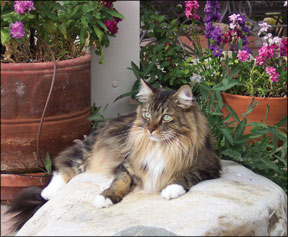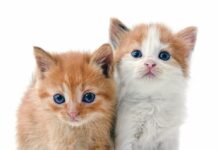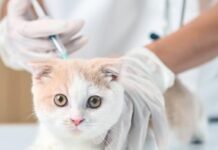Nothing gives you more pleasure on a warm and sunny afternoon than to sit peacefully beside your garden and thrill at the sight of the blossoming lilies, chrysanthemums and foxglove. You especially like the graceful yew shrubs bordering this little patch of earth – a touch you added only recently. And the philodendron thats finally coming into its own, way back there near the fence, is beautiful beyond words.
Your cat sits quietly in your lap, apparently enjoying the view as much as you are. But heaven forbid that she would decide to investigate the garden at close range and show her horticultural

Bev Caldwell
288
appreciation by nibbling at one of the plants.
Tulips, lilies, foxglove, yew shrubs and philodendron are among hundreds of plants that are known to be poisonous to cats. Ingesting just a small leaf of some common ornamental plants could make your little companion quite ill. And without appropriate first aid and prompt veterinary treatment, swallowing a sizable amount could be fatal to her.
Dubious Taste
“We dont know why cats chew on plants,” says Christine Bellezza, DVM, a consultant in the Feline Health Center at Cornell Universitys College of Veterinary Medicine. “It might be out of curiosity, or perhaps out of boredom. But, after all, cats are known to chew on a lot of inedible things. Some poisonous plants may have a bad or bitter taste that will keep a cat from taking more than a nibble. But others dont have a bad taste or smell at all.
“With most poisonous plants, a cat has to swallow quite a bit in order to have a noticeable reaction. But other plants are much more dangerous. It doesnt take much chewing on a lily, for example, for a cat to go into kidney failure.”
The poisonous substances vary from plant to plant, and – depending on the specific toxin – can have damaging, perhaps lethal, impact on a cats gastrointestinal, cardiovascular or nervous system. For example:
u Philodendron, dieffenbachia, skunk cabbage and jack-in-the-pulpit contain oxalate crystals or histamines that can cause esophageal swelling that may interfere with breathing.
- Amaryllis, daffodil, tulip and wisteria plants (and their bulbs) contain gastric irritants that can cause vomiting and nausea immediately after they are swallowed. In severe cases, central nervous system signs may appear, followed by depression, coma and death.
- Foxglove, oleander and lily of the valley contain digitalis glycosides and alkaloids that can cause a slow, irregular heartbeat, intense vomiting, and abdominal pain within a few hours after ingestion. These signs may progress to coma and death.
- Yews contain taxine, a poisonous alkaloid that can cause severe heartbeat irregularities. The consequences will depend on the amount of a yew shrub that has been ingested. If only a small amount has been eaten, nausea, vomiting and abdominal pain will be accompanied by mild neurologic signs. However, yew is so poisonous that death may occur with no prior warning signs of illness.
- Periwinkle and morning glory contain a variety of toxins that can cause behavioral alterations, violent convulsions and tremors.
Unless youve memorized the long list of these and other plants that are known to be harmful to your cat and can recognize all of them by sight, its advisable to assume that just about anything you plant in your garden (except catnip, of course) may pose a threat if ingested.
Indoor Threat
Given the abundance of poisonous plants that flourish in the outside world, is it reasonable to conclude that your cat will be safe if you always keep her indoors? Not at all, says Dr. Bellezza. Indeed, she says, “Indoor cats are probably more inclined to get sick from chewing on plants than outdoor cats are. They dont have as many things to distract them, so they may chew on plants to relieve their boredom.” Indoor cats are especially at risk during holiday seasons, when many people adorn their homes with such poisonous plants as holly, poinsettias and Easter lilies. “Poinsettias are not as poisonous to cats as people have come to believe,” she notes, “but they can certainly cause mouth and gastrointestinal irritation.”
Be wary of plants that well-intentioned visitors give you, she advises, and be sure to keep all plants beyond reach – hanging from a ceiling hook, for example, or on a high and inaccessible shelf. But even then, she observes, an indoor cat may readily chew on leaves that have fallen to the floor from an out-of-reach plant.
Telltale Signs
Indications of plant poisoning vary widely, depending on the type of plant ingested and the specific toxins that it contains. “Some plants taste really bad and might cause your cat to salivate and froth at the mouth right after they are eaten,” Dr. Bellezza points out. “And some toxic plants, like foxglove, can cause serious heart problems that might be immediately apparent. But for plants that cause liver or kidney failure, the signs might not become noticeable for several days.”
If you suspect that your cat is experiencing plant poisoning, she advises, contact your veterinarian immediately or call the American Society for the Prevention of Cruelty to Animals Poison Control Center at (888) 426-4435. Better yet, she suggests, rush the animal to the nearest veterinary clinic. Most importantly, do not try to induce the animal to vomit unless you have been specifically instructed to do so.
Safety Measures
To reduce the chances that your cat will experience plant poisoning, Dr. Bellezza suggests the following:
- Familiarize yourself with the names of the most common poisonous plants; avoid having them in your garden and do not bring them into your home.
- Try using a fence or screen to keep your cat out of your garden. You might also try spraying your plants with a benign substance such as bitter apple, which repels cats.
- Plant a cat-friendly garden, which would include, for example, a patch of harmless grass or catnip; the animal will love to roll around in it and will be distracted from other snacking options. If you use a pesticide, herbicide or fertilizer, read the instructions to make sure that the product is safe for your cat to touch or ingest.
For indoor plants, she advises, be sure to use hanging pots or place your floral arrangements on high shelves that your cat cant reach. Be sure to keep your floors free of fallen plant leaves. And carefully monitor the types of plants and flowers that guests bring into your home.



